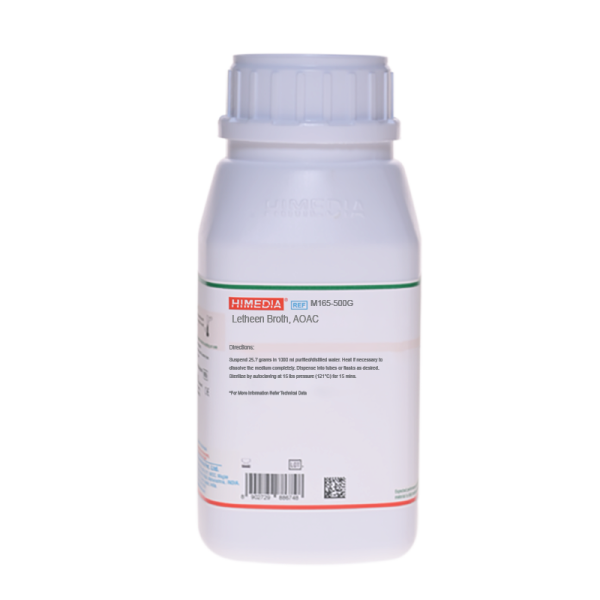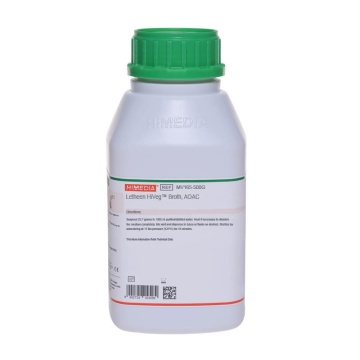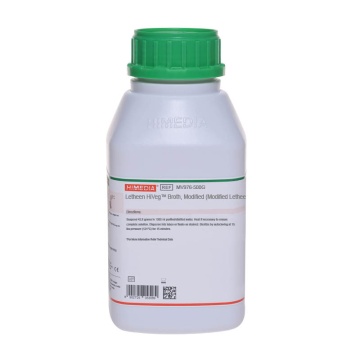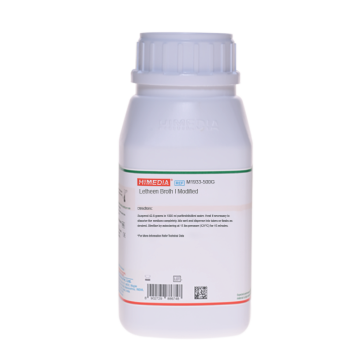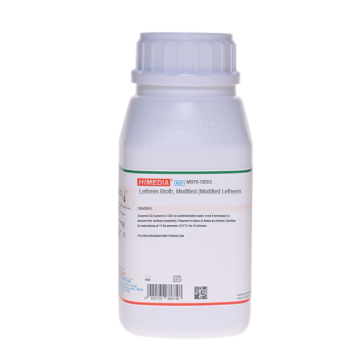 Your enquiry has been submitted
Your enquiry has been submitted
Letheen Broth, AOAC
Environment and Disinfectant Testing #CC293D
Intended Use
Recommended for determination of bacterial activity of quaternary ammonium compounds using Escherichia coli or Staphylococcus aureus ATCC 6538.
Composition**
| Ingredients | Gms / Litre |
|---|---|
| Peptone | 10.000 |
| HM peptone B # | 5.000 |
| Lecithin | 0.700 |
| Polysorbate 80 (Tween 80) | 5.000 |
| Sodium chloride | 5.000 |
Final pH ( at 25°C) 7.0±0.2
**Formula adjusted, standardized to suit performance parameters
# Equivalent to Beef extract
Directions
Suspend 25.7 grams in 1000 ml purified / distilled water. Heat if necessary to dissolve the medium completely. Dispense into tubes or flasks as desired. Sterilize by autoclaving at 15 lbs pressure (121°C) for 15 minutes.
Principle And Interpretation
Letheen Broth was developed by Quisno, Gibby and Foter (7) by the addition of lecithin and Polysorbate 80 to FDA Broth. In the early 40s, Weber and Black recommended the use of lecithin and polysorbate to neutralize the antimicrobial action of the quaternary ammonium compounds (9). Letheen Broth is recommended by AOAC to determine the phenol coefficient of cationic surfactants (6). Letheen Medium is also recommended for testing of cosmetics (8). The medium is also recommended by APHA for microbial testing of water (1).
HM peptone B, Peptone, supply essential nutrients and other trace elements for the microbial growth. Lecithin and polysorbate 80 enables the recovery of bacteria from solutions containing residues of disinfectant used in sanitization of utensils and equipments. Lecithin neutralizes quaternary ammonium compounds and polysorbate 80 neutralizes phenolic disinfectants, hexachlorophene and formalin (2).
Type of specimen
Enviromental samples; Water samples
Specimen Collection and Handling
For enviromental samples, follow appropriate techniques for sample collection and processing as per guidelines (5). For water samples, follow appropriate techniques for sample collection, processing as per guidelines and local standards (2). After use, contaminated materials must be sterilized by autoclaving before discarding.
Warning and Precautions
Read the label before opening the container. Wear protective gloves/protective clothing/eye protection/face protection. Follow good microbiological lab practices while handling specimens and culture. Standard precautions as per established guidelines should be followed while handling specimens. Safety guidelines may be referred in individual safety data sheets.
Limitations
- This medium is general purpose medium and may not support the growth of fastidious organisms.
- Some organism may show poor growth due to nutritional variations.
Performance and Evaluation
Performance of the medium is expected when used as per the direction on the label within the expiry period when stored at recommended temperature.
Quality Control
Appearance: Cream to yellow homogeneous free flowing powder
Colour and Clarity of prepared medium: Light yellow coloured clear solution in tubes
Reaction: Reaction of 2.57% w/v aqueous solution at 25°C. pH : 7.0±0.2
pH: 6.80-7.20
Cultural Response
Cultural characteristics observed after an incubation at 35-37°C for 24-48 hours.
| Organism | Inoculum (CFU) | Growth |
|---|---|---|
| Escherichia coli ATCC 25922 (00013*) | 50-100 | good-luxuriant |
| Staphylococcus aureus subsp. aureus ATCC 6538 (00032*) | 50-100 | good-luxuriant |
| Escherichia coli ATCC 8739 (00012*) | 50-100 | Good-luxuriant |
| Staphylococcus aureus subsp. aureus ATCC 25923 (00034*) | 50-100 | luxuriant |
Key : (*) Corresponding WDCM numbers.
Storage and Shelf Life
Store between 10-30°C in a tightly closed container and the prepared medium at 15-25°C. Use before expiry date on the label. On opening, product should be properly stored dry, after tightly capping the bottle in order to prevent lump formation due to the hygroscopic nature of the product. Improper storage of the product may lead to lump formation. Store in dry ventilated area protected from extremes of temperature and sources of ignition. Seal the container tightly after use. Product performance is best if used within stated expiry period.
Disposal
User must ensure safe disposal by autoclaving and/or incineration of used or unusable preparations of this product. Follow established laboratory procedures in disposing of infectious materials and material that comes into contact with sample must be decontaminated and disposed of in accordance with current laboratory techniques (3,4).
Reference
- Baird R.B., Eaton A.D., and Rice E.W., (Eds.), 2015, Standard Methods for the Examination of Water and Wastewater, 23rd ed., APHA, Washington, D.C.
- Favero (Chm.), 1967, A State of the Art Report, Biological Contamination Control Committee, American Association for Contamination Control.
- Isenberg, H.D. Clinical Microbiology Procedures Handbook 2nd Edition.
- Jorgensen, J.H., Pfaller, M.A., Carroll, K.C., Funke, G., Landry, M.L., Richter, S.S and Warnock., D.W. (2015) Manual of Clinical Microbiology, 11th Edition. Vol. 1.
- MacFaddin J. F., 1985, Media for Isolation-Cultivation-Identification-Maintenance of Medical Bacteria, Vol. 1, Williams and Wilkins, Baltimore.
- Official Methods of Analysis of AOAC International, 21st Ed., Vol.I, 2019, AOAC International, 6.2.04.
- Quisno, R., I.W. Gibby, and M.J. Foter. 1946. Am. J. Pharm. 118:320-323.
- Smart R. and Spooner D.F., 1972, J.Soc.Cosmet. Chem., 23:721.
- Weber and Black, 1948, Am. J. Public Health, 38:1405.
| Product Name | Letheen Broth, AOAC |
|---|---|
| SKU | M165 |
| Product Type | Regular |
| Physical Form | Powder |
| Origin | Animal |
| Packaging type | HDPE |
| References | 1.MacFaddin J. F., 1985, Media for Isolation-Cultivation-Identification-Maintenance of Medical Bacteria, Vol. 1, Williamsand Wilkins, Baltimore. 2.Weber and Black, 1948, Am. J. Public Health, 38:1405. 3.Horwitz, (Ed.), 2000, Official Methods of Analysis of AOAC International, 17th Ed., Vol.I, AOAC International,Gaithersburg, Mb. 4.American Society for Testing and Materials, 1991, Standard Test Methods for preservatives in water-containing cosmetics,E640-7 5.Favero (Chm.), 1967, A State of the Art Report, Biological Contamination Control Committee, American Association forContamination Control. |
| Customized Product Available | No |



